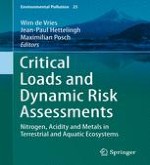2015 | OriginalPaper | Chapter
7. Mass Balance Approaches to Assess Critical Loads and Target Loads of Metals for Terrestrial and Aquatic Ecosystems
Authors : Wim de Vries, Jan E. Groenenberg, Maximilian Posch
Published in: Critical Loads and Dynamic Risk Assessments
Publisher: Springer Netherlands
Activate our intelligent search to find suitable subject content or patents.
Select sections of text to find matching patents with Artificial Intelligence. powered by
Select sections of text to find additional relevant content using AI-assisted search. powered by
